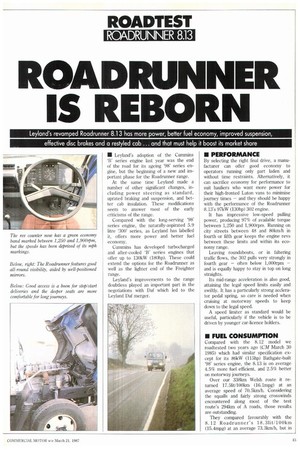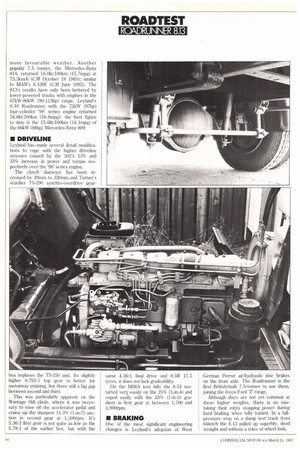ROADRUNNER IS REBORN
Page 45

Page 46

Page 47

If you've noticed an error in this article please click here to report it so we can fix it.
Leyland's revamped Roadrunner 8.13 has more power, better fuel economy, improved suspension, effective disc brakes and a restyled cab ... and that must help it boost its market share
• Leyland's adoption of the Cummins 'B' series engine last year was the end of the road for its ageing '98' series engine, but the beginning of a new and important phase for the Roadrunner range.
At the same time Leyland made a number of other significant changes, including power steering as standard, uprated braking and suspension, and better cab insulation. These modifications seem to answer most of the early criticisms of the range.
Compared with the long-serving '98' series engine, the naturally-aspirated 5.9 litre '300' series, as Leyland has labelled it, offers more power and better fuel economy.
Cummins has developed turbocharged and after-cooled 'B' series engines that offer up to 130kW (180hp). These could extend the options for the Roadrunner as well as the lighter end of the Freighter range.
Leyland's improvements to the range doubtless played an important part in the negotiations with Daf which led to the Leyland Daf merger.
• PERFORMANCE
By selecting the right final drive, a manufacturer can offer good economy to operators running only part laden and without time restraints. Alternatively, it can sacrifice economy for performance to suit hauliers who want more power for their high-fronted Luton vans to minimise journey times — and they should be happy with the performance of the Roadrunner 8.13's 97kW (130hp) 302 engine.
It has impressive low-speed pulling power, producing 97% of available torque between 1,250 and 1,900rpm. Running on city streets between 48 and 80km/h in fourth or fifth gear keeps the engine revs between these limits and within its economy range.
Leaving roundabouts, or in faltering traffic flows, the 302 pulls very strongly in fourth gear — often below 1,000rpm — and is equally happy to stay in top on long straights.
Its mid-range acceleration is also good, attaining the legal speed limits easily and swiftly. It has a particularly strong acclerator pedal spring, so care is needed when cruising at motorway speeds to keep down to the legal speed.
A speed limiter as standard would be useful, particularly if the vehicle is to be driven by younger car-licence holders.
• FUEL CONSUMPTION
Compared with the 8.12 model we roadtested two years ago (CM March 30 1985) which had similar specification except for its 86kW (115hp) Bathgate-built '98' series engine, the 8.13 is on average 4.5% more fuel efficient, and 2.5% better on motorway journeys.
Over our 338km Welsh route it returned 17.51it/100km (16.1mpg) at an average speed of 70.5km/h. Considering the squalls and fairly strong crosswinds encountered along most of the test route's 294km of A roads, those results. are outstanding.
They compared favourably with the 8.12 Roadrunner's 1 8.31it/100km (15.4mpg) at an average 73.31cm/h, but in
more favourable weather. Another popular 7.5 tonner, the Mercedes-Benz 814, returned 18.01it/100km (15.7mpg) at 73.3km/h (CM October 18 1985); similar to MAN's 8.136F (CM June 1985). The 813's results have only been bettered by lower-powered trucks with engines in the 67kW-86kW (90-115hp) range. Leyland's 8.10 Roadrunner with the 72kW (97hp) four-cylinder '98' series engine returned 16.81it/100km (16.8mpg): the best figure to date is the 15.6lit/100km (18.1mpg) of the 66kW (88hp) Mercedes-Benz 809.
• DRFVELINE
Leyland has made several detail modifications to cope with the higher driveline stresses caused by the 302's 13% and 23% increase in power and torque respectively over the '98' series engine.
The clutch diameter has been increased by 20nun to 330mm and Turner's sturdier 15-290 synchro-overdrive gear box replaces the T5-250 unit. Its slightly higher 0.791:1 top gear is better for motorway cruising, but there still a big gap between second and third.
This was particularly apparent on the Wantage Hill climb, where it was necessary to ease off the accelerator pedal and cruise up the sharpest 14.3% (1-in-7) section in second gear at 1,500rpm. It's 5.36:1 first gear is not quite as low as the 5.79;1 of the earlier box, but with the same 4.36:1 final drive and 8.5R 17.5 tyres, it does not lack gradeability.
On the MIRA test hills the 8.13 restarted very easily on the 25% (1-in-4) and coped easily with the 33% (1-in-3) gradient in first gear at between 1,700 and 1,90Orpm.
• BRAKING
One of the most significant engineering changes is Leyland's adoption of West German Perrot air/hydraulic disc brakes on the front axle. The Roadrunner is the first British-built 7.5-tonner to use them, joining the Iveco Ford 'Z' range.
Although discs are not yet common at these higher weights, there is no mistaking their extra stopping power during hard braking when fully loaded. In a fullpressure stop on a damp test track from 64km/h the 8.13 pulled up superbly, dead straight and without a trace of wheel lock. Sharp stops on approaches to roundabouts are equally effective. The only area of uncertainty is during gradual braking on long downhill runs where the action lacks the sensitivity needed to prevent the 8.13 from over-running maximum speed limits.
• HANDLING
7..F power steering is now standard on all Roadrunner models except the shortwheelbase tipper chassis, and it has definitely improved their handling characteristics. It gives easy and positive positioning when squeezing by parked vehicles and the like, and offers an excellent 12.8m turning circle that is only bettered by the Iveco Ford 0813 Cargo. The Roadrunner also has a short cab overhang which enables it to pull out from behind a parked vehicle with less than half a metre of leeway.
• SUSPENSION
In addition to anti-roll bars front and rear as standard, the Roadrunner benefits from semi-elliptic taper leaf springs all round. This arrangement gives a much better ride than before, easily coping with the worst bumps of the MIRA proving
ground's demanding ride-and-handling course.
Only a curious reaction to fine corrugations blotted its copybook on this section of the test, when a regular bouncing motion in the front axle at about 48km/h caused a mild juddering at the steering column.
Out on the winding A roads around Hereford and to the east of Cheltenham the suspension performed faultlessly under a full load.
• CAB COMFORT
Changes to the Roadrunner's cab trim include deeper, more comfortable seats and electrically-heated rearview mirrors. Unfortunately in wet weather dirty spray tends to bake on them.
Good aerodynamics at the front ensures that rain water is drawn away from the side windows, leaving them fairly clear, but the cab shape does not prevent crosswinds from setting up annoying whistling noises around the front grille area. The improved cab insulation is otherwise effective in shutting out wind and engine noise.
As is usual with a Roadrunner cab, access into and across it is particularly easy, which will be a boon for city delivery work. Although the heater and ventilation systems work quite well the controls are stiff and control is imprecise. There are no demist vents for the side windows which tend to mist up in heavy rain.
All switches and controls are easily reached, and Leyland has at last found the correct angle for the accelerator pedal.
• SUMMARY
In the three years since its launch the Roadrunner has become increasingly popular among fleetand owner-operators alike. In its revised, re-engined form it stands to improve on last year's 19_4% share of a market sector that accounts for 14,000 units a year. It is also likely to snatch much of the 14% share once taken by Bedford. As expected the flexible, frugal Cummins engine has enhanced the Roadrunner's performance without affecting its excellent body/payload ratio. Revised suspension, steering and braking have improved its driveability, while better insulation and trim have raised the level of cab comforts.
It is not the cheapest of 7.5 tonners, but the price does compare favourably with similar [yew Ford, MAN, MercedesBenz and Renault Commando models. As long as the new partnership can produce Roadrunners unhindered, it should improve on this year's excellent sales performance to fiecome the jewel in the Leyland Daf crown.
▪ by Bryan Jarvis




















































































